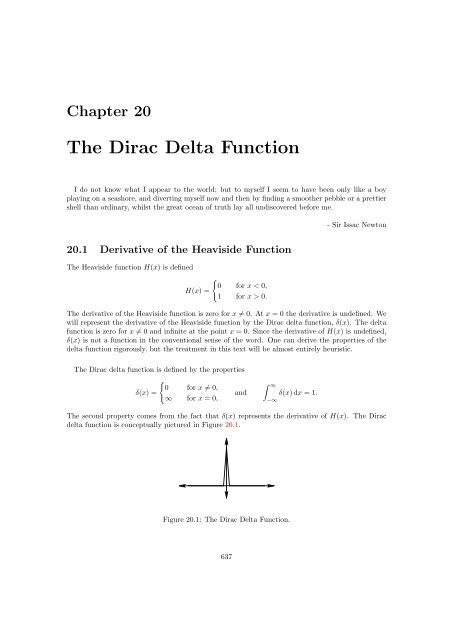The Dirac Delta Function
The Dirac Delta Function
The Dirac Delta Function
You also want an ePaper? Increase the reach of your titles
YUMPU automatically turns print PDFs into web optimized ePapers that Google loves.
Chapter 20<br />
<strong>The</strong> <strong>Dirac</strong> <strong>Delta</strong> <strong>Function</strong><br />
I do not know what I appear to the world; but to myself I seem to have been only like a boy<br />
playing on a seashore, and diverting myself now and then by finding a smoother pebble or a prettier<br />
shell than ordinary, whilst the great ocean of truth lay all undiscovered before me.<br />
20.1 Derivative of the Heaviside <strong>Function</strong><br />
<strong>The</strong> Heaviside function H(x) is defined<br />
H(x) =<br />
�<br />
0 for x < 0�<br />
1 for x > 0.<br />
- Sir Issac Newton<br />
<strong>The</strong> derivative of the Heaviside function is zero for x �= 0. At x = 0 the derivative is undefined. We<br />
will represent the derivative of the Heaviside function by the <strong>Dirac</strong> delta function, δ(x). <strong>The</strong> delta<br />
function is zero for x �= 0 and infinite at the point x = 0. Since the derivative of H(x) is undefined,<br />
δ(x) is not a function in the conventional sense of the word. One can derive the properties of the<br />
delta function rigorously, but the treatment in this text will be almost entirely heuristic.<br />
<strong>The</strong> <strong>Dirac</strong> delta function is defined by the properties<br />
�<br />
0 for x �= 0�<br />
δ(x) =<br />
and<br />
∞ for x = 0�<br />
� ∞<br />
δ(x) dx = 1.<br />
<strong>The</strong> second property comes from the fact that δ(x) represents the derivative of H(x). <strong>The</strong> <strong>Dirac</strong><br />
delta function is conceptually pictured in Figure 20.1.<br />
−∞<br />
Figure 20.1: <strong>The</strong> <strong>Dirac</strong> <strong>Delta</strong> <strong>Function</strong>.<br />
637
Let f(x) be a continuous function that vanishes at infinity. Consider the integral<br />
� ∞<br />
f(x)δ(x) dx.<br />
−∞<br />
We use integration by parts to evaluate the integral.<br />
� ∞<br />
−∞<br />
f(x)δ(x) dx = � f(x)H(x) � ∞<br />
−∞ −<br />
� ∞<br />
= − f � (x) dx<br />
0<br />
= [−f(x)] ∞ 0<br />
= f(0)<br />
� ∞<br />
f � (x)H(x) dx<br />
We assumed that f(x) vanishes at infinity in order to use integration by parts to evaluate the<br />
integral. However, since the delta function is zero for x �= 0, the integrand is nonzero only at x = 0.<br />
Thus the behavior of the function at infinity should not affect the value of the integral. Thus it is<br />
reasonable that f(0) = � ∞<br />
f(x)δ(x) dx holds for all continuous functions. By changing variables<br />
−∞<br />
and noting that δ(x) is symmetric we can derive a more general formula.<br />
� ∞<br />
f(0) = f(ξ)δ(ξ) dξ<br />
−∞<br />
� ∞<br />
f(x) = f(ξ + x)δ(ξ) dξ<br />
−∞<br />
� ∞<br />
f(x) = f(ξ)δ(ξ − x) dξ<br />
−∞<br />
� ∞<br />
f(x) = f(ξ)δ(x − ξ) dξ<br />
This formula is very important in solving inhomogeneous differential equations.<br />
−∞<br />
20.2 <strong>The</strong> <strong>Delta</strong> <strong>Function</strong> as a Limit<br />
Consider a function b(x� �) defined by<br />
b(x� �) =<br />
<strong>The</strong> graph of b(x� 1/10) is shown in Figure 20.2.<br />
−∞<br />
�<br />
0 for |x| > �/2<br />
1<br />
�<br />
10<br />
5<br />
for |x| < �/2.<br />
-1 1<br />
Figure 20.2: Graph of b(x� 1/10).<br />
<strong>The</strong> <strong>Dirac</strong> delta function δ(x) can be thought of as b(x� �) in the limit as � → 0. Note that the<br />
delta function so defined satisfies the properties,<br />
�<br />
� ∞<br />
0 for x �= 0<br />
δ(x) =<br />
and δ(x) dx = 1<br />
∞ for x = 0<br />
638<br />
−∞
Delayed Limiting Process. When the <strong>Dirac</strong> delta function appears inside an integral, we can<br />
think of the delta function as a delayed limiting process.<br />
� ∞<br />
� ∞<br />
f(x)δ(x) dx ≡ lim<br />
�→0<br />
f(x)b(x� �) dx.<br />
−∞<br />
Let f(x) be a continuous function and let F � (x) = f(x). We compute the integral of f(x)δ(x).<br />
� ∞<br />
−∞<br />
20.3 Higher Dimensions<br />
−∞<br />
� �/2<br />
1<br />
f(x)δ(x) dx = lim f(x) dx<br />
�→0 � −�/2<br />
1<br />
= lim [F (x)]�/2<br />
�→0 � −�/2<br />
F (�/2) − F (−�/2)<br />
= lim<br />
�→0 �<br />
= F � (0)<br />
= f(0)<br />
We can define a <strong>Dirac</strong> delta function in n-dimensional Cartesian space, δn(x), x ∈ R n . It is<br />
defined by the following two properties.<br />
δn(x) = 0<br />
�<br />
for x �= 0<br />
δn(x) dx = 1<br />
� n<br />
It is easy to verify, that the n-dimensional <strong>Dirac</strong> delta function can be written as a product of<br />
1-dimensional <strong>Dirac</strong> delta functions.<br />
n�<br />
δn(x) = δ(xk)<br />
20.4 Non-Rectangular Coordinate Systems<br />
k=1<br />
We can derive <strong>Dirac</strong> delta functions in non-rectangular coordinate systems by making a change<br />
of variables in the relation, �<br />
� n<br />
δn(x) dx = 1<br />
Where the transformation is non-singular, one merely divides the <strong>Dirac</strong> delta function by the Jacobian<br />
of the transformation to the coordinate system.<br />
Example 20.4.1 Consider the <strong>Dirac</strong> delta function in cylindrical coordinates, (r� θ� z). <strong>The</strong> Jacobian<br />
is J = r. � ∞ � 2π � ∞<br />
δ3 (x − x0) r dr dθ dz = 1<br />
−∞<br />
For r0 �= 0, the <strong>Dirac</strong> <strong>Delta</strong> function is<br />
since it satisfies the two defining properties.<br />
0<br />
0<br />
δ3 (x − x0) = 1<br />
r δ (r − r0) δ (θ − θ0) δ (z − z0)<br />
1<br />
r δ (r − r0) δ (θ − θ0) δ (z − z0) = 0 for (r� θ� z) �= (r0� θ0� z0)<br />
639
� ∞ � 2π � ∞<br />
1<br />
−∞ 0 0 r δ (r − r0) δ (θ − θ0) δ (z − z0) r dr dθ dz<br />
� ∞<br />
� 2π<br />
= δ (r − r0) dr<br />
For r0 = 0, we have<br />
δ3 (x − x0) = 1<br />
δ (r) δ (z − z0)<br />
2πr<br />
since this again satisfies the two defining properties.<br />
0<br />
0<br />
� ∞<br />
δ (θ − θ0) dθ δ (z − z0) dz = 1<br />
−∞<br />
1<br />
2πr δ (r) δ (z − z0) = 0 for (r� z) �= (0� z0)<br />
� ∞ � 2π � ∞<br />
1<br />
2πr δ (r) δ (z − z0) r dr dθ dz = 1<br />
� ∞ � 2π � ∞<br />
δ (r) dr dθ δ (z − z0) dz = 1<br />
2π<br />
−∞<br />
0<br />
0<br />
640<br />
0<br />
0<br />
−∞

















